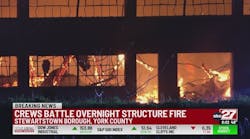Its vista, however, offers fewer and fewer trees; fire watchers quit climbing the zigzagging reach of steps years ago. Instead of forests, the perch near the point where Orange, Osceola, Polk and Lake counties meet now overlooks some of the most aggressive growth in Florida, with rooftops, convenience stores and golf courses splattering across the nearby landscape like a mud pie off of fan blades.
Like many fire lookouts in the state, the Davenport tower is obsolete, leaving little more than memories of a job that once was the bedrock of the state's efforts to control wildfires.
There used to be more than 4,000 such fire towers in the United States. Now there are fewer than 900. Florida has 160 still standing, but many stand idle. In central Florida, they once were used daily, but now only a few are in use and only on days when fire hazards are at a peak, such as during drought or high winds.
''Now you have houses all over the place. Ten years ago, it was pretty well useful,'' said Gary Zipprer, district manager for the state Division of Forestry. ''It covered a lot of the Green Swamp, but now there's so much development it pretty well sticks out.''
The Davenport tower and an adjoining 132 acres were sold in 2000 to Ritchie Bros., an auction company, for $4 million.
The tower still stands tall above a subdivision of stucco homes where residents tend to St. Augustine lawns.
Resident Manuel Mendez, a 17-year-old high school student, said teenagers sneaking up the tower are the only people he ever sees there now. They gain access through a broken gate, he said.
The story is the same in many places, with more than 3 million acres of rural land nationwide per year _ an area a little more than five times the size of Orange County _ being converted to urban use, according to the National Forest Service. Zipprer estimates there is 25 percent less forest in Polk County than there was 10 years ago.
Technology also bypassed towers' usefulness, with cell phones, airplanes and lightning-detection equipment making fire spotting easier than in years past.
Many of the nation's towers have gone the way of the Davenport lookout, sold off to private owners for a variety of uses. When they are no longer useful to fire officials, they are put out to bid. Buyers range from those who simply want the land to those with more creative uses for the towers.
Betty Norman, a real-estate investor in Manatee County, recently closed on a $64,000 deal for a tower site there.
She plans to sell the tower on eBay and have the land rezoned for commercial use. She thinks the land's value in high-growth north Manatee will skyrocket.
Buyers of towers may include people such as John Anderson, 55, of Tavares, who has been shopping around, thinking of using old fire towers to perch wind turbines for making electricity. He hasn't bought one yet.
''It's just an idea. I think that's the future, really,'' he said.
''I hope no one steals my idea.''
While many towers are disappearing, they hold special appeal to many who hope to preserve the history associated with their use. Most of the nation's towers were built in the early 1940s by the Civilian Conservation Corps, a Franklin D. Roosevelt-era program designed to spark the nation's economy and preserve natural resources.
The towers encompass everything from simple steel steps that lead to a platform to homier brick-and-mortar ''lighthouses on land,'' which were popular in the West. Some of those are now available for rent as vacation cabins, while others have been preserved as historic sites.
Arlene Stewart, 63, misses climbing to the place of solitude where for 26 years she stood watch over the forests and fields of Polk County.
The 30-year veteran of the Division of Forestry isn't much of a people person, she said, and loved the days of sitting alone on her watch _ considered at the time a core cog in the firefighting mission.
With towers built about 20 miles apart and views of up to 60 miles on clear days, the fire-spotters had central Florida blanketed like security cameras on the White House lawn.
''I liked the view from up there,'' Stewart said.
''It was beautiful.''
When watchers like Stewart spotted a line of smoke, they reported to the dispatching office. Using landmarks, maps and a knack for judging distances, they gave their best guess on location. Using a magnet on a string, the dispatch office marked the spot on a map with the magnet.
When a second tower watcher called with their report of the same smoke, the magnet and string again got stretched and the spot marked. Firefighters would be dispatched to the spot where the strings crossed.
While the practice is dated, all the towers aren't gone yet. In Lake County, for instance, all four of the state's towers are still used on high-danger days or in times when a plane can't go up, such as during a lightning storm. Osceola has two that are rarely used.
History buffs and nostalgic types hope they stay around, though, and efforts to preserve some towers have gained the government's attention.
The National Forest Service, celebrating 100 years of service this year, is focusing on history and heritage in its promotional efforts, including the role the towers have played.
They have joined with the Forest Fire Lookout Association, a nonprofit group, to save more of the structures _ if not physically, at least in memory through stories, histories and photos.
Hundreds of central Florida adults have memories of school field trips and climbing to the top of the tower to have the watcher explain the job and show them the treetop view, Zipprer said.
Said Zipprer: ''Those kind of folks have fond memories. It's strange. Some people's junk is another's treasure.''





